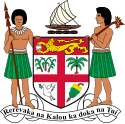1926 Fijian general election
 |
|---|
|
General elections were held in Fiji in 1926.
Electoral system[]
The Legislative Council consisted of 12 official members (eleven civil servants and a British subject not holding public office), seven elected Europeans and two appointed Fijians.[1] The Governor served as President of the Council.
The Europeans were elected from six constituencies; Eastern, Northern, Southern, Suva, Vanua Levu & Taveuni and Western. Voting was restricted to men aged 21 or over who had been born to European parents (or a European father and was able to read, speak and write English) who were British subjects and had been continuously resident in Fiji for 12 months, owning at least £20 of freehold or leasehold property or having an annual income of at least £120, and were not on the public payroll.[1]
| Constituency | Geographical area |
|---|---|
| Eastern | Lau Province, Lomaiviti Province |
| Northern | Ba District, , Ra Province |
| Southern | , Kadavu Province, Naitasiri Province, Namosi Province, Rewa Province (except Suva), Serua Province, Tailevu Province |
| Suva | Suva Municipality |
| Vanua Levu and Taveuni | Bua Province, Cakaudrove Province, Macuata Province |
| Western | , Lautoka District, Nadi District, Nadroga Province |
Results[]
| Constituency | Candidate | Votes | % | Notes |
|---|---|---|---|---|
| Eastern | John Maynard Hedstrom | 73 | 86.9 | Re-elected |
| C. de Mouncey | 11 | 13.1 | ||
| Informal votes | 1 | – | ||
| Northern | Hugh Ragg | 76 | 63.9 | Elected |
| Henry Lamb Kennedy | 43 | 36.1 | Unseated | |
| Informal votes | 2 | – | ||
| Southern | Alport Barker | Unopposed | Re-elected | |
| Suva | Henry Marks | Unopposed | Re-elected | |
| Henry Milne Scott | Unopposed | Re-elected | ||
| Vanua Levu & Taveuni | William Edmund Willoughby-Tottenham | 129 | 70.5 | Elected |
| G. Garrick | 54 | 29.5 | ||
| Informal votes | 8 | – | ||
| Western | 104 | 55.6 | Re-elected | |
| Charles Wimbledon Thomas | 83 | 44.4 | ||
| Informal votes | 7 | – | ||
| Source: Ali | ||||
Aftermath[]
Badri Maharaj was nominated as the member representing Indo-Fijians.[1]
Joni Mataitini and Deve Toganivalu were appointed as the Fijian members, despite Toganivalu having finished third behind Epeli Ganilau in the voting by the Great Council of Chiefs.[2]
References[]
- ^ Jump up to: a b c 1926 Legislative Council Election Fiji Elections Archive
- ^ Ahmed Ali Fiji and the Franchise: A History of Political Representation, 1900–1937
- 1926 elections in Oceania
- 1926 in Fiji
- Elections in Fiji
- 1926 elections in the British Empire